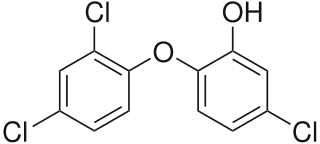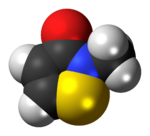
Methylchloroisothiazolinone, also referred to as MCI, is the organic compound with the formula S(C2HCl)C(O)N(CH3). It is a white solid that melts near room temperature. The compound is an isothiazolinone, a class of heterocycles used as biocides. These compounds have an active sulphur moiety that is able to oxidize thiol-containing residues, thereby effectively killing most aerobic and anaerobic bacteria. MCI is often used in combination with methylisothiazolinone, a mixture known as Kathon. The isothiazolinones have attracted attention because they can cause contact dermatitis. Methylchloroisothiazolinone is effective against gram-positive and gram-negative bacteria, yeast, and fungi.

Cosmetics are constituted mixtures of chemical compounds derived from either natural sources, or synthetically created ones. Cosmetics have various purposes. Those designed for personal care and skin care can be used to cleanse or protect the body or skin. Cosmetics designed to enhance or alter one's appearance (makeup) can be used to conceal blemishes, enhance one's natural features, add color to a person's face, or change the appearance of the face entirely to resemble a different person, creature or object. Due to the harsh ingredients in makeup products, individuals with acne-prone skin are more likely to suffer from breakouts. Cosmetics can also be designed to add fragrance to the body.
A biocide is defined in the European legislation as a chemical substance or microorganism intended to destroy, deter, render harmless, or exert a controlling effect on any harmful organism. The US Environmental Protection Agency (EPA) uses a slightly different definition for biocides as "a diverse group of poisonous substances including preservatives, insecticides, disinfectants, and pesticides used for the control of organisms that are harmful to human or animal health or that cause damage to natural or manufactured products". When compared, the two definitions roughly imply the same, although the US EPA definition includes plant protection products and some veterinary medicines.

Oxybenzone or benzophenone-3 or BP-3 is an organic compound belonging to the class of aromatic ketones known as benzophenones. It is a pale-yellow solid that is readily soluble in most organic solvents. It is widely used in sunscreen formulations, plastics, toys, furniture finishes, and other products to limit UV degradation. In nature, oxybenzone can be found in various flowering plants. The compound was first synthesised in Germany by chemists König and Kostanecki in 1906.

Triclosan is an antibacterial and antifungal agent present in some consumer products, including toothpaste, soaps, detergents, toys, and surgical cleaning treatments. It is similar in its uses and mechanism of action to triclocarban. Its efficacy as an antimicrobial agent, the risk of antimicrobial resistance, and its possible role in disrupted hormonal development remains controversial. Additional research seeks to understand its potential effects on organisms and environmental health.

Parabens are chemicals that are commonly used as preservatives in cosmetic and pharmaceutical products. Chemically, they are a series of parahydroxybenzoates or esters of parahydroxybenzoic acid. Research is being conducted to evaluate the potential health implications of paraben usage.
Iodomethane, also called methyl iodide, and commonly abbreviated "MeI", is the chemical compound with the formula CH3I. It is a dense, colorless, volatile liquid. In terms of chemical structure, it is related to methane by replacement of one hydrogen atom by an atom of iodine. It is naturally emitted by rice plantations in small amounts. It is also produced in vast quantities estimated to be greater than 214,000 tons annually by algae and kelp in the world's temperate oceans, and in lesser amounts on land by terrestrial fungi and bacteria. It is used in organic synthesis as a source of methyl groups.

Bronopol is an organic compound that is used as an antimicrobial. It is a white solid although commercial samples appear yellow.

Benzisothiazolinone (BIT) is an organic compound with the formula C6H4SN(H)CO. A white solid, it is structurally related to isothiazole, and is part of a class of molecules called isothiazolinones. BIT is widely used as a preservative and antimicrobial.

Isothiazolinone (sometimes isothiazolone) is an organic compound with the formula (CH)2SN(H)CO. A white solid, it is structurally related to isothiazole. Isothiazolone itself is of limited interest, but several of its derivatives are widely used preservatives and antimicrobials.
The European Chemicals Bureau (ECB) was the focal point for the data and assessment procedure on dangerous chemicals within the European Union (EU). The ECB was located in Ispra, Italy, within the Joint Research Centre (JRC) of the European Commission. In 2008 the ECB completed its mandate. Some of its activities were taken over by the European Chemicals Agency (ECHA); others remained within the Joint Research Centre. The history of the ECB has been published as a JRC technical report.
The Scientific Committee on Consumer Safety (SCCS) is one of the independent scientific committees managed by the Directorate-General for Health and Consumer Protection of the European Commission, which provide scientific advice to the commission on issues related to non-food issues. It is the successor to both the Scientific Committee on Consumer Products (SCCP) and the Scientific Committee on Cosmetic Products and Non-Food Products (SCCNFP).
The Scientific Committee on Health and Environmental Risks (SCHER) is one of the independent scientific committees managed by the Directorate-General for Health and Consumer Protection of the European Commission, which provide scientific advice to the Commission on issues related to consumer products.

A formaldehyde releaser, formaldehyde donor or formaldehyde-releasing preservative is a chemical compound that slowly releases formaldehyde. Formaldehyde-releasers are added to prevent microbial growth and extend shelf life. The intent of these compounds is that they release formaldehyde at levels that suppress microbial growth but sufficiently low to not threaten humans. The use of these chemicals in cosmetics has elicited controversy.
p-Chlorocresol, or 4-chloro-3-methylphenol (ClC6H3CH3OH), also known as p-chloro-m-cresol, is a potent disinfectant and antiseptic. It appears as a pinkish white crystalline solid and has a melting point of 64-66°C. It is also used as a preservative in cosmetics and medicinal products for both humans and animals. It is used as an active ingredient in some preparations of veterinary medicines for tropical, oral and parenteral use. Normally, the concentration of p-Chlorocresol in oral and parenteral veterinary products are 0.1-0.2%. Concentrations are higher (~0.5%) in tropical veterinary products. p-Chlorocresol contains microbial activity against both gram positive and gram negative bacteria and fungi.

Lilial is a chemical compound commonly used as a perfume in cosmetic preparations and laundry powders, often under the name butylphenyl methylpropional. It is an aromatic aldehyde, naturally occurring in crow-dipper and tomato plants, and produced synthetically in large scale. It was banned for use in cosmetics by the EU in March 2022 after being found to be harmful to fertility.

Sodium bisulfite (or sodium bisulphite, sodium hydrogen sulfite) is a chemical mixture with the approximate chemical formula NaHSO3. Sodium bisulfite in fact is not a real compound, but a mixture of salts that dissolve in water to give solutions composed of sodium and bisulfite ions. It appears in form of white or yellowish-white crystals with an odor of sulfur dioxide. Regardless of its ill-defined nature, sodium bisulfite is used in many different industries such as a food additive with E number E222 in the food industry, a reducing agent in the cosmetic industry, and a decomposer of residual hypochlorite used in the bleaching industry.

Iodopropynyl Butyl Carbamate (IPBC) is a water-soluble preservative used globally in the paints & coatings, wood preservatives, personal care, and cosmetics industries. IPBC is a member of the carbamate family of biocides. IPBC was invented in the 1970s and has a long history of effective use as an antifungal technology.

Galaxolide is a synthetic musk with a clean sweet musky floral woody odor used in fragrances. It is one of the musk components that perfume and cologne manufacturers use to add a musk odor to their products. Galaxolide was first synthesized in 1965, and used in the late 1960s in some fabric softeners and detergents. High concentrations were also incorporated in fine fragrances.

(Benzothiazol-2-ylthio)methyl thiocyanate (TCMTB) is a chemical compound classified as a benzothiazole.




















